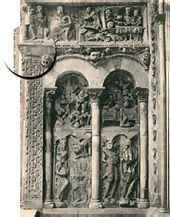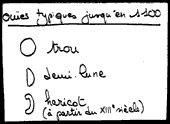Archaeological study :
This study shows that the restorations, intervened at the porch of Moissac, are perfectly discernable?
These restorations mainly concern the lower part of the porch. At the entrance of the porch, on the left side, a talemon will appear around 1925 as we can see on the cards below.


Before 1925 (left) et after 1925 (right)
On the right side appear decorative patterns with four-leaf clover shapes, above the right archway.
Below on the left, the angel Gabriel will be entirely re-sculpted by Perrin during Violle Le Duc's works.
The arabesques were restored during these works.
In the tympanum, phalanxes of an old character had been lengthened (picture right).


Two heads of ancients had also been reconstructed in baked clay or something like that.

It is necessary to signal an anomaly at the bottom concerning the olds.
On the right side two blocks could have been inverted.
Bent Joergensen explains that four characters do not have their heads naturally turnedtoward the Christ, while their neighbours do .
Concerning these four characters, their instruments are perfectly authentic, except one, easily identifiable.
Study of instruments :
As the sculpture is three-dimensional, it gives much information, but also many interrogations. The sculptor tried to show us that the back of the instrument was flat: a rebeckes with a flat bottom, or a woodblock (vièle).
The reported part of the neck is present on no less than three instruments, but can we really speak of a reported neck?
Are not we in a turning point area where the neck is built in a solid wood and is placed higher than the body?
For the first time in the musical iconography , three (cordiers) are decorated with four-leaf flowers.
St Jacques of Compostelle proposed these decorations, 80 years later, but more geometrically on many instruments.

Two assemblings in strings are particularly strange:
- One where the bass string (bourdon) is at the place of the high string (chanterelle)
- The second where two strings are locked at the same pin

In these two cases, I dare to propose two hypothesises :
In Moissac the pins are of a strange modernity. It also happened in Bordeaux during the same 12° century , which is reassuring .
Is it a purely regional reality?
In Moissac, all the bridges are perfectly centred between the sound holes of which the profile seems to be studied for this reason?
Usually , the sound holes met in the iconography until the beginning of the 12th century are represented as simple holes or half-moon motifs and later as bean shape .
Moissac offers an incredible diversity. No less than thirteen different motifs .



